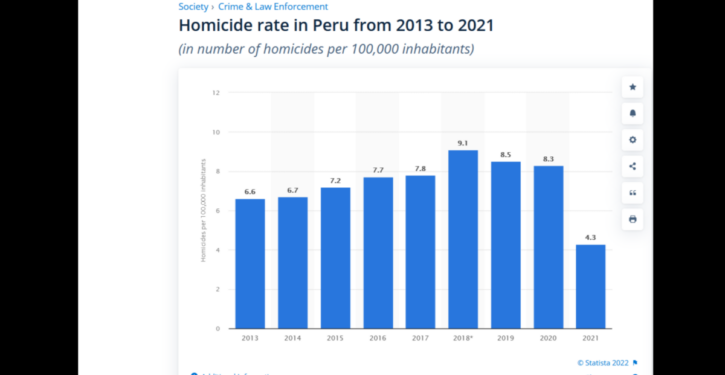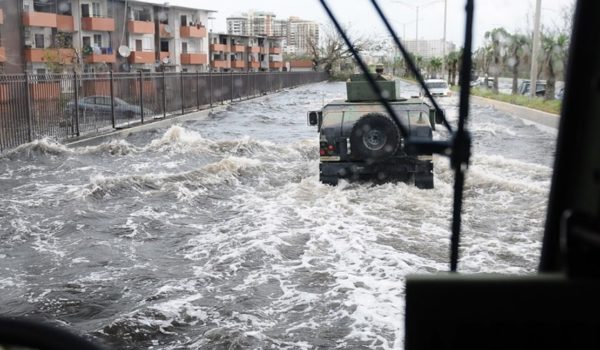
Progressives sometimes claim, contrary to a ton of evidence, that crime rose since 2020 due to the coronavirus pandemic. For example, a Philadelphia Inquirer columnist claimed today that the COVID-19 pandemic “triggered a nationwide short-term spike in homicides and some other categories of violent crime” in the United States. But most countries had falling murder rates during the pandemic, even those with higher death rates than the U.S., or higher rates of economic distress or collapse.
Peru has had the world’s highest coronavirus death rate per million people. In 2020, its death rate from the coronavirus was three times as high as America’s. Even today, according to public health statistics, Peru’s death rate is roughly double America’s (6,430 per million, compared to 3,240 per million in the U.S.)
So if being hit hard by the coronavirus caused murder to rise, Peru should have seen skyrocketing murder rates. But the opposite happened. Peru’s homicide rate fell by one-half during the pandemic, as you can see from the bar graph above. As Statista.com notes, Peru’s homicide rate fell from 8.5 per 100,000 inhabitants in 2019, to 8.3 per 100,000 inhabitants in 2020, all the way down to a mere 4.3 per 100,000 inhabitants in 2021.
Peru is not unique. Homicide rates fell in many countries, such as France, Italy, and Japan, in 2020, even though they suffered more economically from the pandemic. The U.S. economy shrank 3.5% in 2020. The economy shrank much more in Europe: 7.9% in France, and 8.9% in Italy, for example. Japan’s economy shrank 4.8%.
Mexico’s homicide rate fell in 2020, even though Mexico and the United States lost similar fractions of their citizens to the coronavirus, and even though Mexico’s economy crashed much worse than the United States’s during the pandemic. Murder rates also fell in other countries hit hard by the epidemic, like France and Italy.
COVID-19 caused widespread hunger in Latin America, unlike the United States. Yet murder rates fell in 2020 in Guatemala, Honduras, Venezuela, and El Salvador — all countries where malnutrition, already widespread, became worse due to the epidemic. Their economies shrank more in 2020 due to the coronavirus: Venezuela’s economy shrank 10%, El Salvador’s 9%, and Honduras’s 6.6%. By contrast, the U.S. economy shrank only 3.5%.
One factor in rising violence in 2020 may have been falling incarceration rates, which resulted in violent offenders being released from jail or not jailed in the first place. The number of people in America’s prisons and jails dropped by 14% from 2019 to mid-2020.
It’s possible that murders are higher in the United States partly because it has fewer police than Europe, making it harder to solve serious crimes and catch dangerous criminals. In inner cities, murders are also more common because some people refuse to help police solve crimes, which they regard as “snitching.” Less cooperation with police in America’s inner cities makes it harder to catch criminals and thus deter crime.
The U.S. has fewer police per homicide than European nations (and far fewer police per homicide than Japan or Australia). And despite its reputation for supposed “mass incarceration,” the U.S. actually incarcerates fewer people per homicide than Australia, Japan, and six European countries. America’s large prison population is mainly a function of America’s big population and big crime rate, which means it has more dangerous criminals it needs to keep off the streets. Only 4% of state inmates were imprisoned for drug possession in 2015. Most were imprisoned for “violent offenses.”
The U.S. does incarcerate more people per homicide than other European countries, which often give murderers ridiculously short sentences. U.S. sentences are longer than the typical European sentence, but this is offset by lower clearance rates for murder in the U.S. than in many European countries, which means that murderers in the U.S. — especially our inner cities — are often never even caught or punished at all, resulting in less deterrence. Because of lower clearance rates, and less willingness by people in inner cities to cooperate with investigators and the police, the U.S. needs to have longer prison sentences than Europe, just to have the same deterrent effect. If a criminal knows he probably won’t be caught, then the sentence he receives if he actually does get caught needs to be longer to compensate for the lower likelihood of getting caught. Indeed, because clearance rates are much more important for deterring crime than sentence length is, if clearance rates fall by 10%, sentences for those caught will need to rise by 20% or far more to compensate.



